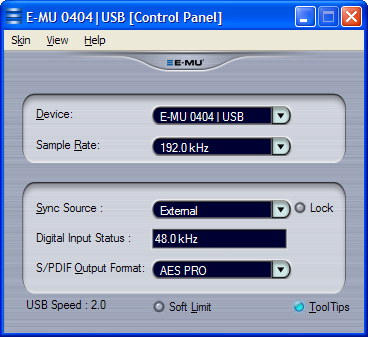 |
||
|
||
| ||
Drivers Drivers installation was flawless on every testbed. Controls were as simple as they could be: a single modes window with all the controllers on the interface itself. Working with ASIO interface, drivers automatically determine and set the required sampling rate. ASIO buffer can be resized without any problems, re-launching, etc., but it can only be done via the ASIO Control Panel. The native control panel doesn't have anything resembling buffer size. Perhaphs, it's fixed for the MME interface. Drivers also lack the MME auto sample rate option. Subjective testingFor subjective tests the interface was connected directly to ADAM S2.5A monitors. We used high-quality records of various styles obtained by digital EAC copying from CD-DA and DVD-Audio sources. The interface was to compete with ESI Juli@ and E-MU 1212M - the best products in their class offered (that's also important) for a similar price. All three devices produced similar professional sound. However we could hear the difference on the top-end ADAM S2.5A acoustic system. Comparing to Juli@, 0404 USB sounded in considerably more detail and produced better attack. We listened to tens of tracks instantly switching from one recording to another. And without a doubt the classic ESI Juli@, one of the best PCI devices out there with AK4358 DAC, yielded to this external interface with the top-end AK4396 converter. The 1212M card has the same converters as LynxTWO and ProTools HD 192 have and belongs to the mastering product class. In the majority of recordings 0404 USB slightly yielded to 1212M in quality. In some cases we could notice tembre differences between AK4396 and CS4398 that didn't benefit either solution. Anyway, given the similar price, 0404 USB is more comfortable to use than 1212M: automatic sampling rate adjustment vs. creating new projects in Patchmix 1212M; hardware volume control of 0404 USB vs. software slider in Patchmix. Add to this connection comfort, headphones output... And if you have cheaper monitors, the benefits of 1212M fade even more. According to the vendor, relatively to other products, 0404 USB is a slightly pared-down M-class, which is still better than non-M. Usage of the same pre-amplifiers as AudioDock 1616 has provides higher pre-amplifier quality than that of the original 1820M.
PerformanceBuilt-in pre-amplifiers performed well and didn't produce noise even at strong amplification (just the white noise, according to spectrum analyzer.) One peculiarity is that controllers allow to set amplification of up to +65 dB. However combined with Oktava MK319, amplification, exceeding about 62 dB, causes pre-amplifier self-excitation (perhaps, due to circuit design) and produces distinctive noise instead of signal. But let's not consider this a disadvantage - the vendor honestly rated pre-amplification at +60 dB. A soft limiter is a useful feature that allows to avoid signal clipping at when signal pickup is a little bit over the limit. The only issue we had was with coaxial SPDIF input. For some reason it started to work only after we fed it an AES/EBU signal from LynxTWO. Perhaps, the signal level, not the protocol, was incorrect. There were no problems with optical interface. The built-in headphones pre-amplifier has output impedance of 22 Ohm and max. output power of 20 milliwatt. Like mic pre-amplifiers, it's A-class, so it should be enough for the majority of popular headphones (though it's still not recommended to connect those super low-Ohm ones with impedance below 22 Ohm). Note that the headphone signal is produced by the primary DAC, not a separate lower-quality one, like they do it in some interfaces. The 0404 USB amplifier did perfectly well with both high-Ohm Sennheiser HD580 and budget low-Ohm AKG K44. We could find no evident differences, comparing it to the amplifier of Mackie BigKnob. High-quality amplifiers of both devices do not cause signal distortion. Just note the higher power potential of BigKnob. ConclusionsOur tests showed that E-MU's new professional USB interface justified our expectations and got very close to the best PCI cards from the angle of sound quality produced with top-class monitors. It differs favourably from E-MU's PCI cards by simpler and more user-friendly controls. Our measurements with Aurora 8 also confirmed that the interface has a really high-quality path. It's a major step forward for external interfaces that hardly provide 100 dB SNR with dirty spectrum. At that 0404 USB has only stereo input and output, so you won't have to pay for multiple channels, which you do not require. Instead, you will get a top-end AKM's DAC, high-quality pre-amplifiers, headphone amplifier, and user-friendly controls. In the end we'll just mention the rather affordable price and congratulate E-MU with such a successful external USB interface. We can easily recommend EMU 0404 USB for use in home and project studios, for out-of-studio sound recording, and just as a high-quality solution for listening to music (in headphones as well.) Pro:
Contra:
According to our test results, E-MU 0404 USB gets the "Original Design" award for a technological breakthrough in the field of external USB interfaces.  Write a comment below. No registration needed!
|
Platform · Video · Multimedia · Mobile · Other || About us & Privacy policy · Twitter · Facebook Copyright © Byrds Research & Publishing, Ltd., 1997–2011. All rights reserved. |